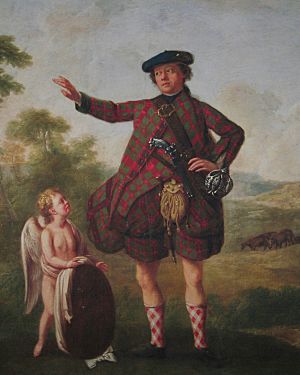Threipland baronets facts for kids
The Threipland Baronetcy was a special title given to a family from Fingask, in a place called Perth, Scotland. It was part of something called the Baronetage of Nova Scotia. This title was first given to Patrick Threipland on November 10, 1687.
A Baronetcy is like a hereditary title, meaning it can be passed down through the family, usually from father to son. It's a bit like being a knight, but the title stays in the family. The Threipland family lived at Fingask Castle in Perthshire, which was their main home.
Contents
What is a Baronetcy?
A Baronetcy is a title of honour that is passed down through a family. It's not a noble title like a Duke or Earl, but it's still a very respected position. The title "Sir" is used before the name of a Baronet. The Threipland Baronetcy was created in the Baronetage of Nova Scotia, which means it was set up when Scotland had its own special system for creating these titles.
Key People in the Threipland Baronetcy
This section tells you about the people who held the Threipland Baronet title. Sometimes, things happened that made the title stop for a while.
The First Baronet
- Sir Patrick Threipland, 1st Baronet (died 1689): He was the very first person to receive this special title in 1687.
Challenges to the Title
- Sir David Threipland, 2nd Baronet (died 1746): David inherited the title from his father. However, in 1715, something happened that caused his title to be taken away. This was because of his involvement in political events of the time. When a title is "attainted" and "forfeited," it means it's officially taken away by the government.
- Sir Stuart Threipland, de jure 3rd Baronet (1716–1805): Even though his father's title was taken away, Stuart was still considered the rightful heir by many. He was a doctor and served as a physician to Bonnie Prince Charlie. This was during a big event in Scottish history called the Jacobite rising of 1745. Stuart was also the leader of the Royal Medical Society for several years, from 1766 to 1770.
Getting the Title Back
- Sir Patrick Murray Threipland, 4th Baronet (1762–1837): Many years later, in 1826, Patrick worked to get the family's title back. He succeeded, and the decision to take the title away was reversed. This meant the Baronetcy was officially recognized again.
- Sir Patrick Murray Threipland, 5th Baronet (1800–1882): He was the last person to hold the title. When he passed away in 1882, the Threipland Baronetcy either ended completely or became "dormant." "Dormant" means it might still exist but there's no one currently recognized to hold it.
Images for kids





